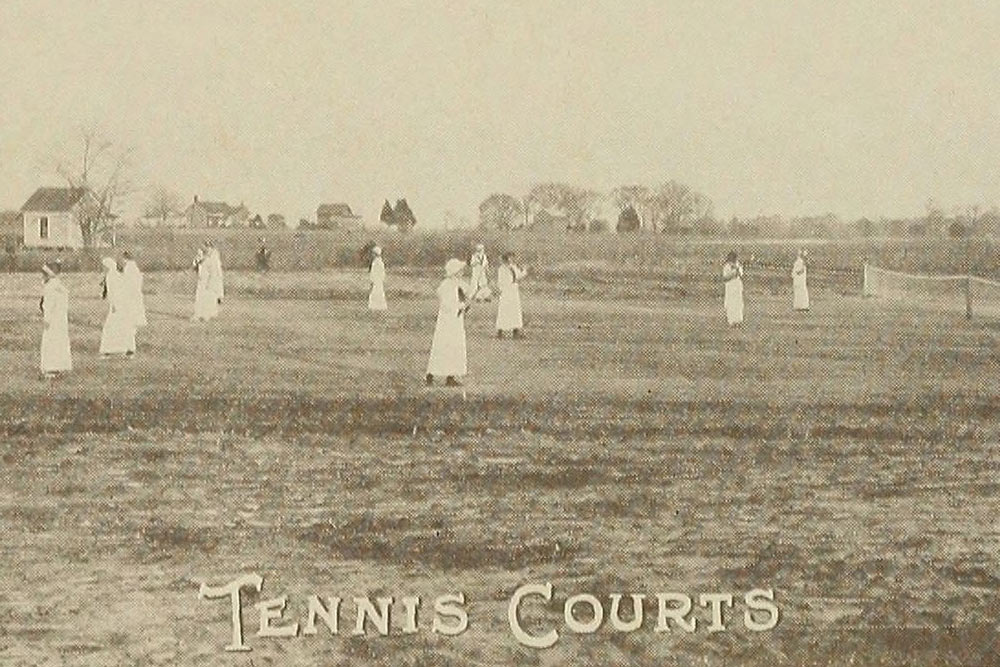
Other than the short-lived 1910 baseball team which played local high school teams, athletic activity at the Training School took the form of individual participation or intramural competition. When ECTTS first opened, it was equipped with two basketball courts and four tennis courts plus a vast expanse of wooded area for walking. But within a few years, the number of tennis courts had increased to ten. Although basketball was by far the most popular sport on campus during the Training School era, tennis and cross-county walking were quite popular as well. The increased number of tennis courts surely reflected student demand for that sport. Over the next several decades of East Carolina’s history, tennis remained one of the more popular and accessible sports on campus.
Organized athletic activity in the form of intramural competitions started during the 1913-1914 academic year, with an emphasis on involving “the greatest possible number of students.” A 1915 issue of the Training School Quarterly (vol. 1, no. 4) provides the first picture of tennis on campus. It accompanied an article by Mabel M. Comfort, the faculty member who had a key role in organizing students into the campus athletic league. While the campus tennis picture appeared prominently above photos of cross-country walkers, the frontispiece for the volume featured a photograph of students playing basketball. These are the first known pictures of athletics at East Carolina Teachers Training School. Their presentation well reflected the hierarchy of popular sports.
The decision to promote these sports was utilitarian: in allocating resources for athletics, the main question was which would serve the largest number of people and provide, presumably, the greatest level of happiness. Baseball, requiring considerable space but only involving nine players per team, did not compare with space requirements and student demand for basketball, tennis, and hiking. Basketball was viewed as the most worthy because of the number of players per team, five, plus the space required to stage a game: a fraction of that needed for baseball. The same was true, though less so, with tennis. More students wanted to be involved in these activities – basketball, tennis, and cross-country walking – than in baseball. As a result, campus resources were geared toward basketball first and foremost, then tennis, then cross-country walking. Baseball, a men’s sport, vanished with declining male enrollment. Indicative of the popularity of tennis, the Training School Quarterly observed “practically all the tennis courts are filled every afternoon.”
To encourage interest, student teams were organized according to class and curriculum, and then competitions organized around them. By organizing competitions, sportsmanship as well as athletics was taught, and school spirit cultivated as well. Tryouts for the tennis teams began after the Christmas holidays, in January, with a series of intra-class games. The best players were encouraged to enter the next set of contests. By March 15, the team of four was selected on the basis of skill, teamwork, and practice performance. The best two were deemed the regular players, and the other two alternates. Interclass games were played for the following month to determine the final contestants in the tournament, held in early May. The athletic league awarded a cup to the winner of the tournament.
By staging tennis competitions after the basketball season, the school maximized student interest in the sport. Initially, the two competitions had run in tandem, but without the best results in terms of interest for tennis. As with basketball, the ultimate objective was to teach the students how to organize and participate in an athletic league so that they might organize the same for schools where they would later teach. By participating, students and in turn their future students gained the chance to stay physically fit, and learn “the principles of honor and justice, courage, courtesy and self-discipline.”
Sources
- Comfort, Mabel M. “Organized Out-of-Door Sports.” Training School Quarterly. Vol. 1, no. 4. January, February, March, 1915. Raleigh: Edwards & Broughton, 1915. Pp. 220-223.
- “Junior Class Winners of the Loving Cup.” Greenville News. June 1, 1920. P. 1.
- “The Athletic League.” Training School Quarterly. Vol. 1, no. 4. January, February, March, 1915. Raleigh: Edwards & Broughton, 1915. P. 267.
Citation Information
Title: Tennis
Author: John A. Tucker, PhD
Date of Publication: 6/12/2018